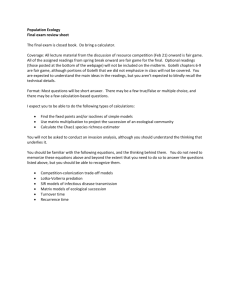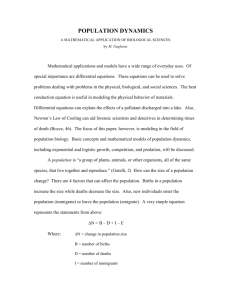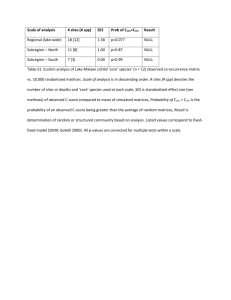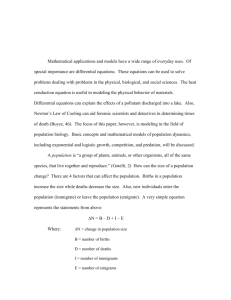Comments
advertisement
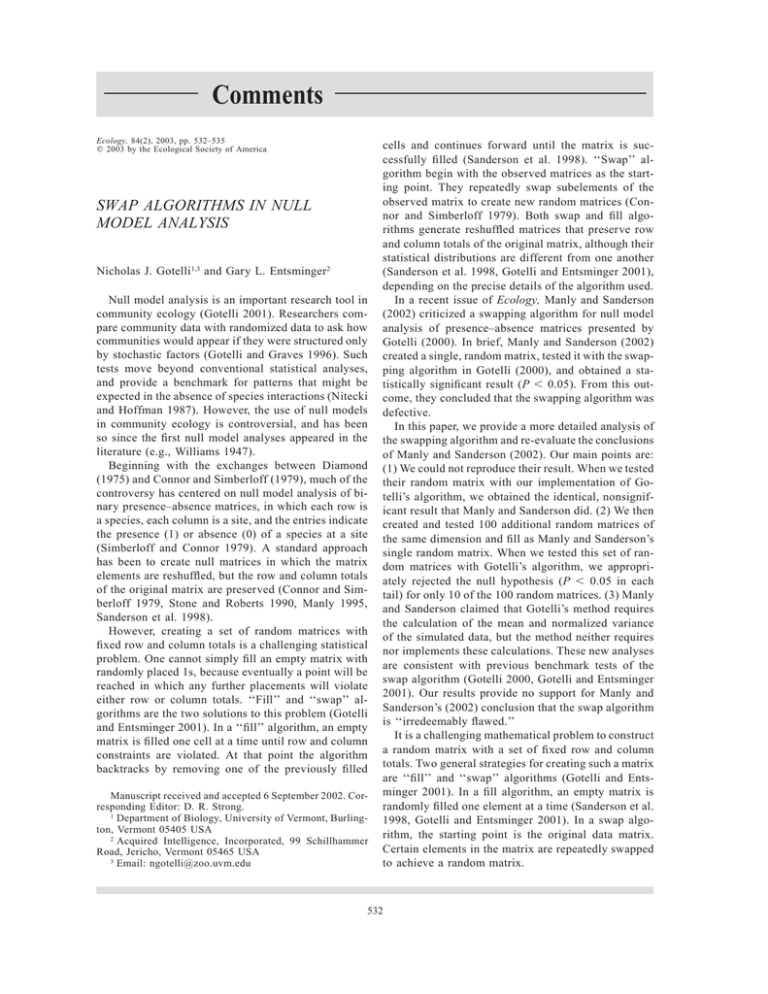
Comments Ecology, 84(2), 2003, pp. 532–535 q 2003 by the Ecological Society of America SWAP ALGORITHMS IN NULL MODEL ANALYSIS Nicholas J. Gotelli1,3 and Gary L. Entsminger2 Null model analysis is an important research tool in community ecology (Gotelli 2001). Researchers compare community data with randomized data to ask how communities would appear if they were structured only by stochastic factors (Gotelli and Graves 1996). Such tests move beyond conventional statistical analyses, and provide a benchmark for patterns that might be expected in the absence of species interactions (Nitecki and Hoffman 1987). However, the use of null models in community ecology is controversial, and has been so since the first null model analyses appeared in the literature (e.g., Williams 1947). Beginning with the exchanges between Diamond (1975) and Connor and Simberloff (1979), much of the controversy has centered on null model analysis of binary presence–absence matrices, in which each row is a species, each column is a site, and the entries indicate the presence (1) or absence (0) of a species at a site (Simberloff and Connor 1979). A standard approach has been to create null matrices in which the matrix elements are reshuffled, but the row and column totals of the original matrix are preserved (Connor and Simberloff 1979, Stone and Roberts 1990, Manly 1995, Sanderson et al. 1998). However, creating a set of random matrices with fixed row and column totals is a challenging statistical problem. One cannot simply fill an empty matrix with randomly placed 1s, because eventually a point will be reached in which any further placements will violate either row or column totals. ‘‘Fill’’ and ‘‘swap’’ algorithms are the two solutions to this problem (Gotelli and Entsminger 2001). In a ‘‘fill’’ algorithm, an empty matrix is filled one cell at a time until row and column constraints are violated. At that point the algorithm backtracks by removing one of the previously filled Manuscript received and accepted 6 September 2002. Corresponding Editor: D. R. Strong. 1 Department of Biology, University of Vermont, Burlington, Vermont 05405 USA 2 Acquired Intelligence, Incorporated, 99 Schillhammer Road, Jericho, Vermont 05465 USA 3 Email: ngotelli@zoo.uvm.edu cells and continues forward until the matrix is successfully filled (Sanderson et al. 1998). ‘‘Swap’’ algorithm begin with the observed matrices as the starting point. They repeatedly swap subelements of the observed matrix to create new random matrices (Connor and Simberloff 1979). Both swap and fill algorithms generate reshuffled matrices that preserve row and column totals of the original matrix, although their statistical distributions are different from one another (Sanderson et al. 1998, Gotelli and Entsminger 2001), depending on the precise details of the algorithm used. In a recent issue of Ecology, Manly and Sanderson (2002) criticized a swapping algorithm for null model analysis of presence–absence matrices presented by Gotelli (2000). In brief, Manly and Sanderson (2002) created a single, random matrix, tested it with the swapping algorithm in Gotelli (2000), and obtained a statistically significant result (P , 0.05). From this outcome, they concluded that the swapping algorithm was defective. In this paper, we provide a more detailed analysis of the swapping algorithm and re-evaluate the conclusions of Manly and Sanderson (2002). Our main points are: (1) We could not reproduce their result. When we tested their random matrix with our implementation of Gotelli’s algorithm, we obtained the identical, nonsignificant result that Manly and Sanderson did. (2) We then created and tested 100 additional random matrices of the same dimension and fill as Manly and Sanderson’s single random matrix. When we tested this set of random matrices with Gotelli’s algorithm, we appropriately rejected the null hypothesis (P , 0.05 in each tail) for only 10 of the 100 random matrices. (3) Manly and Sanderson claimed that Gotelli’s method requires the calculation of the mean and normalized variance of the simulated data, but the method neither requires nor implements these calculations. These new analyses are consistent with previous benchmark tests of the swap algorithm (Gotelli 2000, Gotelli and Entsminger 2001). Our results provide no support for Manly and Sanderson’s (2002) conclusion that the swap algorithm is ‘‘irredeemably flawed.’’ It is a challenging mathematical problem to construct a random matrix with a set of fixed row and column totals. Two general strategies for creating such a matrix are ‘‘fill’’ and ‘‘swap’’ algorithms (Gotelli and Entsminger 2001). In a fill algorithm, an empty matrix is randomly filled one element at a time (Sanderson et al. 1998, Gotelli and Entsminger 2001). In a swap algorithm, the starting point is the original data matrix. Certain elements in the matrix are repeatedly swapped to achieve a random matrix. 532 COMMENTS February 2003 Swap algorithms seek out submatrices of the following form: 01 10 or 10 01 The elements of these submatrices (which do not have to be physically adjacent) can be interchanged to create a new random matrix, but the row and column totals of the original matrix will always be preserved. The algorithm is like a tiled picture puzzle, in which adjacent tiles are repeatedly swapped to create a random rearrangement of the original picture. Gotelli (2000) and Manly (1995) used two slightly different versions of the swap. Gotelli (2000) used 1000 initial swaps from the original matrix to remove transient effects, and then retained the next set of 1000 swaps to form the null set. Manly (1995) used no initial swaps, but created two swapping sequences of random length, each beginning from the original matrix. The two sequences were combined to produce a set of 1000 null matrices. Manly’s (1995) method is based on the theoretical work of Besag and Clifford (1989) for estimating tail probabilities from simulated distributions; Gotelli’s method simply treats the set of matrices as a random sample of all possible matrices with fixed row and column totals. Following Manly and Sanderson (2002), we refer to these two algorithms as the ‘‘Gotelli Swap’’ and the ‘‘Manly Swap.’’ A third approach is to use the Gotelli Swap to create a single random matrix without retaining any of the consecutive matrices in the null set. A fresh start is taken with another set of swaps for the next random matrix. In this ‘‘Independent Swap,’’ there is no serial correlation between matrices, which are each produced by unique swapping sequences (Gotelli and Entsminger 2001). Manly and Sanderson (2002) created a single 15 3 15 presence–absence matrix and randomly filled it with 1s and 0s. When they tested it 20 times with the Manly Swap, they rejected the null hypothesis (P , 0.05) three times, with an average P value of 0.071. When they tested the same matrix 20 times with the Gotelli Swap, they rejected the null hypothesis every time, with an average P value of 0.041. Based on this result, Manly and Sanderson (2002) concluded that the Gotelli Swap was defective. We disagree with their conclusions based on three substantive points. First, Manly and Sanderson (2002:582) claim that tail probabilities in the Gotelli Swap are calculated by comparison with the mean and standard deviation of the simulated matrices. This is incorrect. We simply compare the observed community co-occurrence index with its position in the tail of the simulated distribution, as is standard in Monte Carlo testing (Manly l991). We 533 TABLE 1. Twenty independent results obtained using the Gotelli Swap (EcoSim Version 3.0). Result no. Tail probability Average C score 1 2 3 4 5 6 7 8 9 10 11 12 13 14 15 16 17 18 19 20 Average 1 SD 0.088 0.086 0.075 0.119 0.063 0.070 0.079 0.073 0.069 0.056 0.091 0.073 0.075 0.076 0.084 0.072 0.055 0.087 0.081 0.108 0.079 (0.015) 13.775 13.772 13.763 13.782 13.752 13.765 13.771 13.756 13.770 13.757 13.772 13.762 13.760 13.775 13.772 13.771 13.751 13.767 13.768 13.785 13.767 (0.009) 1 SD 0.092 0.088 0.091 0.107 0.093 0.089 0.090 0.095 0.091 0.085 0.094 0.090 0.093 0.092 0.090 0.094 0.090 0.092 0.093 0.091 0.092 (0.004) Notes: The random data matrix in Manly and Sanderson (2002: Table 1) was used, and our calculation of the observed C score (C 5 13.9429) agrees with that reported by Manly and Sanderson (2002). Each of the 20 trials is based on 1000 simulated matrices. The tail probability, average C score, and standard deviation of the C score for each trial are presented, as in Sanderson and Manly (2002). Grand averages and standard deviations (in parentheses) are given in the last two rows. These results should be compared to Manly and Sanderson (2002: Table 3), in which the same algorithm was implemented, but the null hypothesis was rejected in all 20 trials. have calculated standardized effect sizes (Gotelli and McCabe 2002), but only in the context of meta-analysis (Gurevitch et al. 1992), and not for the purposes of determining tail probability values. Second, it is unwise to draw conclusions about the behavior of a null model based on the analysis of a single data matrix (Gotelli 2001), as Manly and Sanderson (2002) have done. Therefore, we created 100 random 15 3 15 matrices and tested their behavior with the Gotelli Swap. We tested each of the 100 random matrices using 1000 different null matrices. Before the first null matrix was created, 1000 initial transpositions were used to remove transient effects. Matrices were created and tested in EcoSim Version 3.0 (Gotelli and Entsminger 2002), the version of our software that was cited by Manly and Sanderson (2002). We also tested the version of the Gotelli Swap that we implemented in EcoSim 7.0. This version uses 30 000 initial transpositions. Finally, we used EcoSim 7.0 to test a version of the Independent Swap in which consecutive matrices are not retained, and each null matrix is created by 30 000 independent transpositions. Using each algorithm, we then tallied the number of matrices out of COMMENTS 534 TABLE 2. Ecology, Vol. 84, No. 2 Consistent results of different swap algorithms. Algorithm Gotelli Swap Gotelli Swap Independent Swap Manly Swap Gotelli Swap Source EcoSim 3.0 EcoSim 7.0 EcoSim 7.0 Manly and Sanderson (2002) Manly and Sanderson (2002) No. significant trials 0 0 0 3 20 Tail probability 0.079 0.078 0.077 0.071 0.041 (0.015) (0.019) (0.008) (0.022) (0.009) Average C score 13.767 13.756 13.752 13.750 13.730 (0.009) (0.013) (0.004) (0.013) (0.012) 1 0.092 0.124 0.124 0.127 0.113 SD (0.004) (0.007) (0.007) (0.009) (0.006) Notes: All tests use the random 15 3 15 matrix presented in Manly and Sanderson (2002: Table 1). Out of 20 simulation trials, results are presented for the number of significant results (P , 0.05), average P value, C score, and standard deviation. Standard deviations for each of these averages are given in parentheses. Only Manly and Sanderson’s (2002) implementation of the Gotelli Swap generated nonrandom results for their random test matrix. the 100 for which the null hypothesis was rejected (P , 0.05) in either tail of the distribution. For a set of 100 random matrices, a well-tempered null model should reject the null hypothesis for approximately 5 matrices in each tail of the distribution. We obtained this result for all 3 of the swap algorithms we tested. There was no evidence of an excessive Type I error rate for the Gotelli Swap, which confirms other benchmark tests (Gotelli 2000, Gotelli and Entsminger 2001). Third, we were unable to reproduce the results reported in Manly and Sanderson (2002). When we applied the Gotelli Swap as implemented in EcoSim 3.0 to the random matrix they presented in their Table 1, we never rejected the null hypothesis in 20 trials, and generated an average P value of 0.079 (Table 1). The different variants of the swap algorithm that we tested did not produce identical distributions, but they all gave comparable results that were not qualitatively different from Manly and Sanderson’s (2002) version of the Manly Swap (Table 2). Most important, the results of our implementation of the Gotelli Swap are similar to those of the Independent Swap, in which there is no serial correlation of random matrices. The results presented here reaffirm the extensive benchmark tests in Gotelli (2000) and Gotelli and Entsminger (2001), as well as the hundreds of unpublished tests we have performed on the Gotelli Swap during software development. Our results are also consistent with other explorations of sequential swap algorithms by Stone and Roberts (1990) and A. Zaman and D. Simberloff (unpublished manuscript). We would never assert that our programs are error-free. However, our implementation of the Gotelli Swap produces unique matrices in the correct frequencies that are predicted by a theoretical analysis (Appendix in Gotelli and Entsminger 2001). Manly and Sanderson (2002) have claimed that the single matrix they presented is random, and all of our tests point to the same conclusion (Tables 1, and 2). We appreciate that there are a wide variety of approaches to null model analysis and to computer programming, and we are not claiming that the Gotelli Swap is the best or the only algorithm that should be used in null model analysis. Nevertheless, we do not accept Manly and Sanderson’s (2002) conclusion that the Gotelli Swap algorithm is ‘‘irredeemably flawed.’’ The most prudent method for evaluating null model algorithms is to test their performance on a large number of random and structured matrices (Gotelli 2001), which we have done for the Gotelli Swap and other related algorithms (Gotelli 2000). In this way, frequencies of Type I and Type II errors can be measured. Acknowledgments We thank Aaron Ellison and Andrew Solow for comments on the manuscript. EcoSim software development is supported by NSF grant DEB 01-07403. Literature cited Besag, J., and P. Clifford. 1989. Generalized Monte Carlo significance tests. Biometrika 76:633–642. Connor, E. F., and D. Simberloff. 1979. The assembly of species communities: chance or competition? Ecology 60: 1132–1140. Diamond, J. M. 1975. Assembly of species communities. Pages 342–444 in M. L. Cody and J. M. Diamond, editors. Ecology and evolution of communities. Harvard University Press, Cambridge, Massachusetts, USA. Gotelli, N. J. 2000. Null model analysis of species co-occurrence patterns. Ecology 81:2606–2621. Gotelli, N. J. 2001. Research frontiers in null model analysis. Global Ecology and Biogeography Letters 10:337–343. Gotelli, N. J., and G. L. Entsminger. 2001. Swap and fill algorithms in null model analysis: rethinking the knight’s tour. Oecologia 129:281–291. Gotelli, N. J., and G. L. Entsminger. 2002. EcoSim: null models software for ecology. Version 7.0. Acquired Intelligence and Kesey-Bear, Jericho, Vermont, USA. ,http:// homepages.together.net/;gentsmin/ecosim.htm. Gotelli, N. J., and G. R. Graves. 1996. Null models in ecology. Smithsonian Institution Press, Washington, D.C., USA. Gotelli, N. J., and D. J. McCabe. 2002. Species co-occurrence: a meta-analysis of J. M. Diamond’s assembly rules model. Ecology 83:2091–2096. Gurevitch, J., L. L. Morrow, A. Wallace, and J. S. Walsh. 1992. A meta-analysis of field experiments on competition. American Naturalist 140:539–572. February 2003 COMMENTS Manly, B. F. J. 1991. Randomization and Monte Carlo methods in biology. Chapman and Hall, London, UK. Manly, B. F. J. 1995. A note on the analysis of species cooccurrences. Ecology 76:1109–1115. Manly, B., and J. G. Sanderson. 2002. A note on null models: justifying the methodology. Ecology 83:580–582. Nitecki, M. H., and A. Hoffman. 1987. Neutral models in biology. Oxford University Press, Oxford, UK. Sanderson, J. G., M. P. Moulton, and R. G. Selfridge. 1998. Null matrices and the analysis of species co-occurrences. Oecologia 116:275–283. 535 Simberloff, D., and E. F. Connor. 1979. Q-mode and R-mode analyses of biogeographic distributions: null hypotheses based on random colonization. Pages 123–138 in G. P. Patil and M. L. Rosenzweig, editors. Contemporary quantitative ecology and related ecometrics. Volume 12. Statistical ecology. International Cooperative Publishing House, Fairland, Maryland, USA. Stone, L., and A. Roberts. 1990. The checkerboard score and species distributions. Oecologia 85:74–79. Williams, C. B. 1947. The generic relations of species in small ecological communities. Journal of Animal Ecology 16:11–18. ERRATUM The recent paper by Richard Law, David J. Murrell, and Ulf Dieckmann (2003) entitled ‘‘Population growth in space and time: spatial logistic equations,’’ Ecology 84(1):252–262, was published without information about how to access the Appendix referred to twice on p. 257. We apologize to the authors and to our readers for this omission. The following notice should have appeared at the end of the paper: APPENDIX An evaluation of several moment closures for the dynamical system in Eqs. 4 and 5 (including the one given as Eq. 6) is available in ESA’s Electronic Data Archive: Ecological Archives E084-012-A1.
